Initial Research
Before start working on anything, it is necessary to understand the feature in and out. It helps to empathize with users and deciding the scope of the product.
The initial process starts with talking to people, how they communicate with other team members on Flock and why there is a need for mailing lists.
Understanding Flock Communication
In Flock, people communicate with others through two ways, either one on one chat or in a channel. Channels on Flock is where the real magic happens! Team members use channels for departments, small teams, and projects to keep everyone in the loop.
Understanding Mailing list
A mailing list is a list of emails and names of individuals to send emails to many recipients.
In organizations; people use mailing list in different departments for different purposes. This includes HR, IT, Admins for the announcement. Teams use for project discussions. Sales and marketing for sending emails to target users.
Need of mailing lists
From past many decades, people use emails as a primary source of official communication, but in past few years, the trend has changed. Now people communicate more on chat platforms like Slack, Hangout chats, Flock, etc.
Still, emails have advantages over chat, and people prefer emails for essential communication. Due to the nature of chats and limitations, mailing lists are still popular and important part of any organization.
Work | Baggage Tracker

Baggage Tracker
UBER Assignment
Concept app to track Airport baggage status from baggage check-in till baggage collection.
Problem Statement
A traveler has landed at San Francisco International Airport and needs to find her checked bag. Create interaction flow that helps the traveler find her bag from her mobile app.
Validating of Problem Statement
After getting the problem statement, my first action was to validate the problem statement. I did this by talking to few people and getting some idea of real-life scenario. To get the whole picture I mapped user journey from airport check-in till collecting baggage from the conveyor belt.
User Journey Mapping
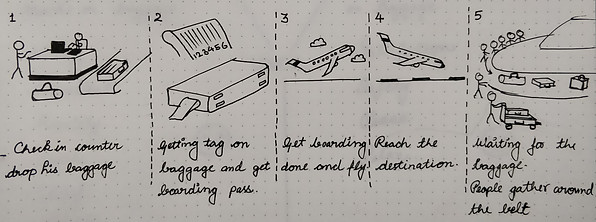
From check-in till collecting baggage, there are multiple steps and emotions involved. On the basis of my own experience and talking to different users I came up with a user journey. This involves few generic steps like;
• Waiting on check-in counter
• Submitting baggage
• Getting baggage tag
• Security checking
• Waiting for boarding
• Sitting and settling hand baggage
• Reach destination
• Waiting for baggage
• Identifying own baggage
• Booking cab
• Informing parents or friends through call or messages etc.
These involve emotions which comes from their past experiences or comes naturally like;
• Worry about their baggage when they don't have a track on their belongings.
• They act very impatient and gather around the belt.
• They feel restless and tired from the journey.
• Few always in a hurry to leave the airport and reach home.
• Few get paranoid when they don’t find their baggage not coming on the conveyor belt.
User Persona & Scenario

Name - Jennifer
Age - 32 Yrs
Gender - Female
Occupation - Professional Photographer
Status - Married
Location - New York, USA
Activities & Attributes:
• She is very efficient in advance technology.
• Fly most of the time to different places for work.
• Get very few time to spend for herself at any place.
• Always in hurry to finish work.
• Very punctual with her timings and commitments.
• Fluently use mobile applications, laptop, and I-pad.
Fears:
• She always carries expensive photography equipment and has fear to lose them.
• Always worry to miss any event or get late.
Goals:
• To get everything on track.
• Save time and relax or utilize it whenever she gets a chance.
Scenario:
Jennifer is traveling from New York to San Francisco for her new photography project. She is traveling from flight and carrying all types of photography equipment with her. All of them are important and costly as well. She had an incident when her baggage got misplaced and she got it back after 2 hours. Due to this, she always became worried about her baggage from the time she drops them at the check-in counter
This time she is looking for something which can help her keep track on her baggage and travel carefree.
After doing this exercise, I got some idea of what problem I need to solve and what experience user needs. Given problem statement does not include the whole experience and might break it. So I thought of a holistic picture of this scenario which gave me the ability to think about a possible solution to this problem.
Further Research
To come up with a good solution, I tried to understand the process of airport baggage handling systems and how they currently work. Without this, we won’t be able to give a solution which is feasible and more practical to implement.
Secondary research helped me understand this process, with some web articles and informative videos.

Airports Baggage Handling System (BHS)
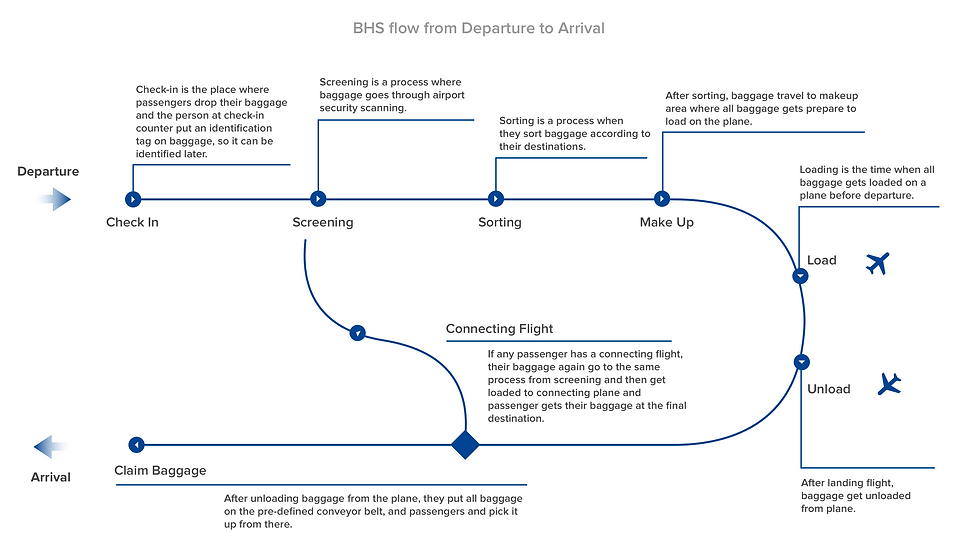
Possible Solution
An app which user can use only when they are standing and waiting for their baggage doesn’t make any sense. Rather we can make full baggage tracking application which user can install at the time of check-in and start tracking from there only. This solution will make the application more usable and helpful.
Available Technologies
RFID tags, GPS and NFC are the technologies which can be used for tracking any object. Each technology has its own usages, RFID tags are widely used to keep track on objects. Recently Beijing Airport started using RFID tags to keep track on Baggages on the airport. By using the same technology we can achieve this experience for the user.
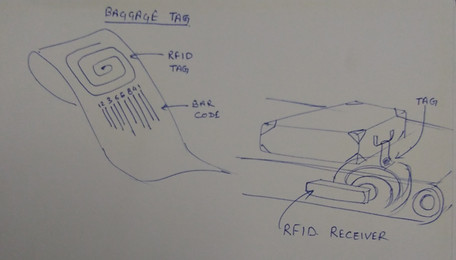
RFID Baggage tag and read by RFID Receiver
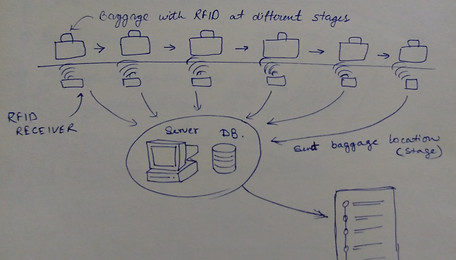
Management and tracking of baggage
What is useful for user ?
There are so many steps involved in baggage handling system, but all steps are not relevant to the user. We can show following steps from BHS which might be useful for a user.
• Baggage Check-in
• Security check
• Baggage loaded on flight
• Baggage unloaded from flight
• Baggage arrived at the belt
• View Baggage on belt
When a user lands on the airport and waiting for his baggage, we can send him notification whenever his baggage arrives at the belt.
Till then the user can book a cab for himself or sit and relax at some place or maybe take few selfies at the airport.
To give an end to end experience to the user, we can give him the ability to track his baggage on the conveyor belt. So s/he will not get any difficulty to find his baggage.

How to make full baggage journey trackable using RFID tags

Initial paper wireframes and flow

Information Architecture
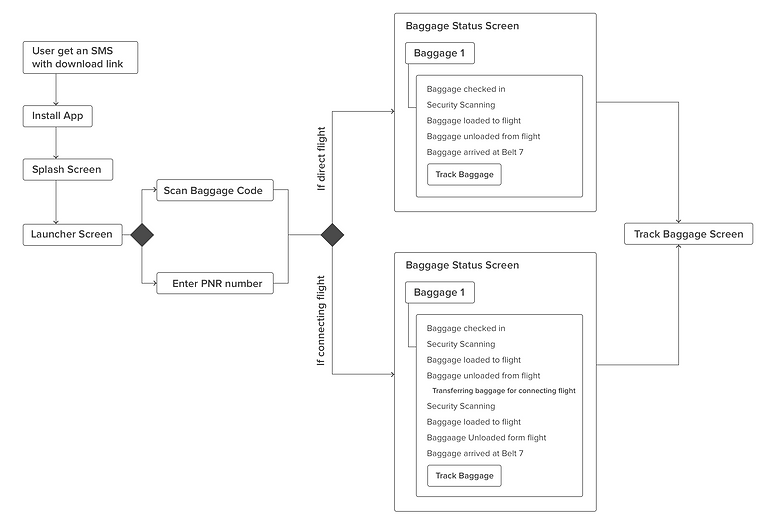
Wireframes
Once user drops his baggage on check-in counter and gets baggage tag, the passenger will get an SMS with a link to download Application.
When a user opens app, it will show a splash screen with some graphics to engage the user till app get a load.

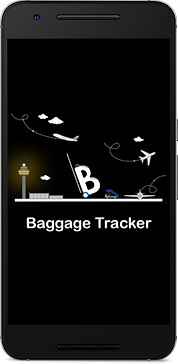
Once app load, it will start back camera of the device and ask the user to scan baggage code. In any case if user is unable to scan code s/he can choose the option to enter PNR number.
If the user clicks on “Enter you PNR number” it will slide up and show an input field to let the user enter PNR number.


Once the user successfully scans baggage code or enter valid PNR number, it will detect baggage info and show the status of his baggage.
By default “Baggage check-in” will be marked as checked and it will always show the upcoming stage of baggage.
Latest baggage status will be on top, and previous will follow down. The reason being user would always want to see the latest status of baggage and not the older status.
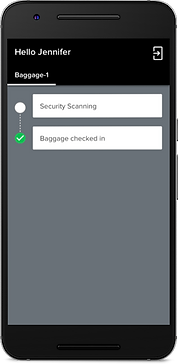
Status for user will be;
1. Baggage Check-in
2. Security Scanning
3. Loaded to flight <Flight no.>
4. Unloaded from flight <Flight no.>
5. Waiting to arrive at <Belt no.>
5.1 Baggage arrived at <Belt no.>
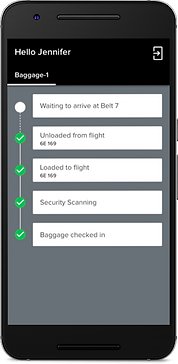
Once baggage arrive at belt, waiting status will change to “Baggage arrived at <Belt no.>”
along with a button to “Track Baggage”.
Once Baggage arrives at the belt, the user will get a notification to get his baggage from the belt.
“Your baggage has arrived at <Belt no.>”


If the user clicks on Notification or clicks on “Track Baggage” button, it will open a screen in which user can see the actual position on the belt in real time.
If passenger has more than one Baggage
If a passenger has more than one baggage, then it will show other tabs as baggage 2 and so forth.
Each baggage status will update separately.


Once the user clicks on “Track Baggage” it will show all arrived baggage position at the belt.
If one baggage has arrived and another one is still waiting to arrive, it will not show that one at the belt, and show the baggage disabled on the top bar.
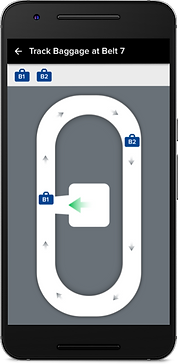

If passenger has connecting flights
If the user has any connecting flight; after unloading it will show transferring baggage for connecting flight and after that process will continue further.
In this case, there will be the following status for user after unloading from flight;
5. Security Scanning
6. Loaded to connecting flight <Flight no.>
7. Unloaded from connecting flight <Flight no.>
8. Waiting to arrive at <Belt no.>
8.1 Baggage arrived at <Belt no.>
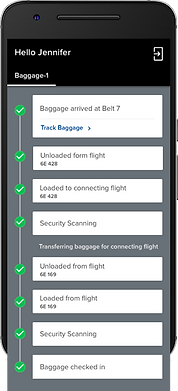
User Flow with screens and description
